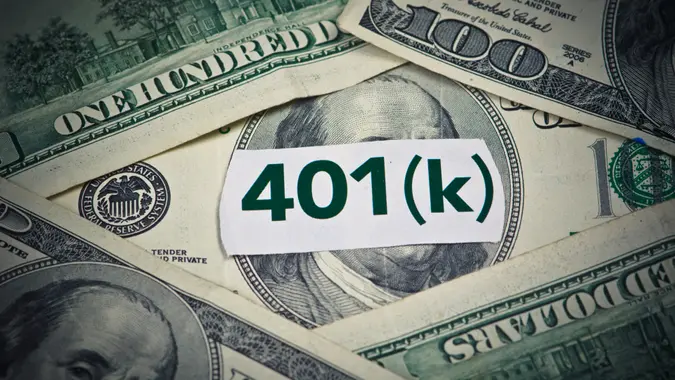5 Ways Boomers Saved for Retirement That Won’t Work for Younger Generations

Commitment to Our Readers
GOBankingRates' editorial team is committed to bringing you unbiased reviews and information. We use data-driven methodologies to evaluate financial products and services - our reviews and ratings are not influenced by advertisers. You can read more about our editorial guidelines and our products and services review methodology.

20 Years
Helping You Live Richer

Reviewed
by Experts

Trusted by
Millions of Readers
Retirement planning has evolved, and strategies that worked for baby boomers may no longer be effective for others.
With fewer company pensions, rising interest rates and shifting economic policies on the horizon, younger generations face unique challenges. Relying on job security, employer-provided benefits, or low-risk investments aren’t safe bets for people younger than 60, forcing them to evaluate the current financial landscape and adapt accordingly.
Here are the five ways boomers saved for retirement that won’t work for younger generations.
Company Pensions
The number of companies that offer a traditional defined benefit (DB) pension plan that pays a lifetime annuity has decreased over the past 30 years.
According to the latest data from the U.S. Bureau of Labor Statistics, only 15% of private industry workers had access to a defined benefit plan.
“With the move to 401(k)s and IRAs, the responsibility for saving and investing has largely shifted to individuals,” said Christopher Stroup, founder and president of Silicon Beach Financial. “Younger generations must now actively contribute to these plans, choose their investments and manage their portfolios.”
In addition, Stroup said individuals must also bear the consequences of poor investment decisions or insufficient savings because 401(k) balances are subject to market performance.
Lower Cost of Living
Both boomers and younger generations dealt with inflation and stagnation during their prime earning years.
“It may surprise Gen Z to learn that the baby boomers did not have a smooth ride in their early years,” said Kevin Connor, founder and CEO of Modern SBC, a strategic branding and communications company. “The 1970s and 1980s were difficult economic times, with challenges are easily forgotten today.”
However, wage stagnation coupled with job insecurity and rising living costs make it more difficult for younger generations to save for retirement.
“With higher expenses for housing, healthcare and education, many younger workers struggle to prioritize long-term savings,” Stroup said. “In contrast, boomers benefitted from higher wages and more affordable living costs during their working years.”
Social Security
The future of Social Security in the next decade is uncertain, despite political promises to the contrary.
“Relying on Social Security is riskier for millennials and Gen Z because of concerns over the program’s long-term sustainability due to potential benefit cuts and rising life expectancies,” Stroup said. “Unlike boomers, who received more generous benefits, younger generations may face reduced payouts or need to rely more on personal savings.”
Unless Congress and President-elect Donald Trump act in the next four years, the Social Security trust fund face a shortfall. According to the 2024 report by the Social Security Board of Trustees, the trust fund will be depleted in 2034 and “unable to pay scheduled benefits in full on a timely basis in 2035.” In addition, the federal program will only be able to pay 83% of scheduled benefits.
Real Estate
Stroup said boomers have used homeownership as a key asset for retirement — one that might not be available to younger generations.
“Rising home prices and difficulty buying property have delayed homeownership for younger generations, which has limited their ability to build equity,” Stroup said. “Millennials and Gen Z face added financial strain that reduces their capacity to save for retirement.”
According to a recent Freddie Mac survey, as of 2024, 65 million baby boomers accounted for 36% of the nation’s homeowner households. Baby boomer’s overall wealth since the pandemic increased to $486,000 per household, half of which is due to house price appreciation.
In addition, the survey found that half of boomer homeowners already owned their home outright, and 53% of those still paying off a mortgage have an interest rate below 4%, compared to the current average of nearly 7% today for a 30-year, fixed mortgage rate.
Lower Student Loan Payments
According to a recent report from the Education Data Initiative, the average student borrower owes $4,080 more than the average boomer borrower, and 40% of boomer student borrowers have loan payments of less than $200.
“Larger student loan debt and other financial obligations divert resources away from retirement savings for younger generations,” Stroup said. “Many are forced to prioritize paying off loans or covering everyday expenses. This trade-off disrupts traditional savings strategies and hinders long-term financial security for younger generations.”
More From GOBankingRates
- Nearly 1 in 3 Americans Hit by a Costly Holiday Scam, Norton Survey Shows -- How To Avoid This
- Here's What the Average Social Security Payment Will Be in Winter 2025
- How Middle-Class Earners Are Quietly Becoming Millionaires -- and How You Can, Too
- The Easiest Way to Score $250 for Things You Already Do
 Written by
Written by  Edited by
Edited by 

























